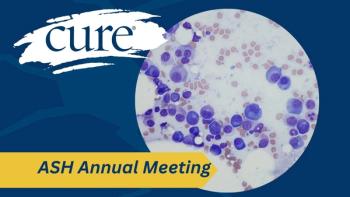
Identifying Patients Who Will Benefit From Intensified Prostate Cancer Treatment
Key Takeaways
- Advanced digital pathology and biopsy analysis are used to identify patients who benefit from intensified prostate cancer treatment.
- The STAMPEDE trial demonstrated that adding Zytiga to standard therapy halved recurrence risk and improved survival in high-risk patients.
Dr. Nicholas James shares why it’s important to identify which patients with high-risk, non-metastatic prostate cancer will benefit from intensified treatment.
Identifying men with high-risk, non-metastatic prostate cancer who will truly benefit from intensified treatment from therapeutic approaches like Zytiga (abiraterone) plus standard therapy is a growing need, as 60% of patients do well on standard therapy alone, according to Dr. Nicholas James.
Researchers, like James, are now using advanced digital pathology and tools to analyze biopsy samples to assist in identifying patients for personalized therapy. To best understand this rationale, we sat down for an interview with James to discuss why is it important to identify which patients will truly benefit from intensified treatment.
James is a professor of Prostate and Bladder Cancer Research, as well as a group leader in Prostate and Bladder Cancer Research, at The Institute of Cancer Research and The Royal Marsden Hospital, located in London, England.
CURE: Why is it important to identify which patients with high-risk prostate cancer will truly benefit from intensified treatment? What have recent trials like STAMPEDE shown about adding Zytiga (abiraterone) to standard therapy in this population?
It's self-evident that if a patient receives a treatment they don't need, they will only experience side effects with no benefit. The way treatments tend to evolve — and as your question hints, this is true of all therapies, not just cancer therapies—is that we select a population of patients and hypothesize that a drug might work well for them. We then compare their outcomes with patients who did not receive the new treatment to see who fares better.
In the particular trial we're reporting results from here, we studied patients with aggressive prostate cancer — cancers with a high risk of spreading, but where, to our knowledge, the cancer had not yet spread. We know from experience that these patients have a high chance of recurrence after their initial treatment.
The patients we treated in this cohort had high-risk prostate cancer, meaning a very high risk of recurrence after initial treatment. The standard treatment for these patients involves two to three years of androgen deprivation, which switches off the production of male hormones, combined with a course of high-dose radiotherapy to the prostate and potentially to the pelvic lymph nodes if deemed necessary. Even with this approach, depending on how patients are selected, [the disease will ultimately recur in about] 30% to 40% of cases. Conversely, this also means that 60% to 70% of patients will do fine with the standard treatment.
In the STAMPEDE trial, which is apparently the only trial with mature results from this type of experiment, we took patients receiving standard treatment and divided them into two groups. Half received the standard treatment, while the other half received the standard treatment plus two years of a hormone therapy drug called Zytiga. Zytiga is approved for use in metastatic prostate cancer — prostate cancer that has spread. Initially, it was used in patients whose cancer had recurred after initial treatment, essentially as a palliative treatment.
For men newly diagnosed with high-risk or metastatic prostate cancer, how has the timing and duration of treatments like Zytiga changed based on recent research findings?
Subsequently, based on my own trial, STAMPEDE, and a second trial called LATITUDE, we found that it worked better when given to newly diagnosed men with metastatic disease. On average, they lived about a third longer than patients for whom we reserved Zytiga or similar drugs for later use. So, if you are diagnosed with widespread disease, drugs like Zytiga, and a number of others with similar results, are part of the standard of care. However, if you have disease that might spread but hasn't yet, there's much less data, and STAMPEDE is the only trial that has provided data on this.
What we found was that giving just two years of Zytiga treatment to this high-risk group of men halved the risk of the cancer recurring after treatment concluded. These men received a fixed period of treatment—two to three years — and then stopped all treatment. We observed that even five years later, the relapse rate remained halved, which is a great result. As you might expect, if you don't relapse, you are not very likely to die from prostate cancer, and this translated into a 40% improvement in the risk of death from prostate cancer. This is a truly significant finding.
How are researchers working to better understand which individuals with prostate cancer truly benefit from additional therapies?
Going back to the issue of overtreatment, 60% of the patients were doing fine with the standard treatment. All those men had received Abiraterone but wouldn't benefit from it because they would have done well without it. So that presents an interesting problem in how we manage treatment now.
In this particular part of the study, we obtained tissue blocks from the diagnostic samples of these men, all of whom had undergone a biopsy to confirm their prostate cancer diagnosis. We got hold of the biopsies, and there's a standard way of staining them with something called hematoxylin (H&E is the abbreviation). This gives you a standard pathology picture, which the pathologist examines to confirm prostate cancer and also to give it a grade, predicting how aggressive it's likely to be. All these patients had high-grade prostate cancers, as already confirmed in their diagnosis.
What we did in the trial was to get these initial pathology slides and digitally scan them. So, we now had a digital image, not a physical glass slide with a bit of tissue on it. We then collaborated with a company called Artera.
For more news on cancer updates, research and education, don’t forget to





